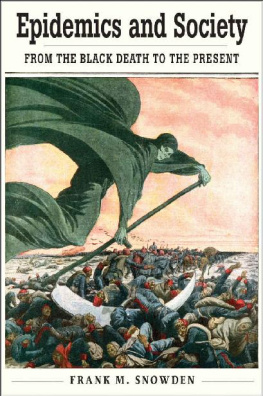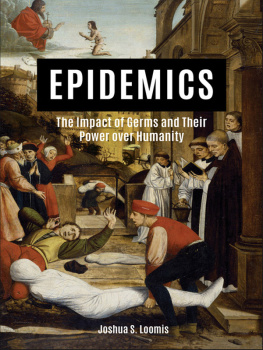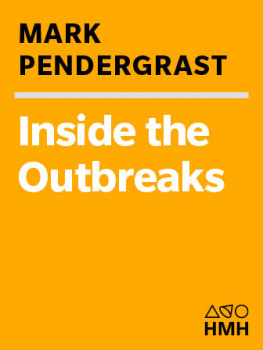Epidemics and Society
THE OPEN YALE COURSES SERIES is designed to bring the depth and breadth of a Yale education to a wide variety of readers. Based on Yales Open Yale Courses program (http://oyc.yale.edu), these books bring outstanding lectures by Yale faculty to the curious reader, whether student or adult. Covering a wide variety of topics across disciplines in the social sciences, physical sciences, and humanities, Open Yale Courses books offer accessible introductions at affordable prices.
The production of Open Yale Courses for the internet was made possible by a grant from the William and Flora Hewlett Foundation.
BOOKS IN THE OPEN YALE COURSES SERIES
Paul H. Fry, Theory of Literature
Roberto Gonzlez Echevarra, Cervantes Don Quixote
Christine Hayes, Introduction to the Bible
Shelly Kagan, Death
Dale B. Martin, New Testament History and Literature
Giuseppe Mazzotta, Reading Dante
R. Shankar, Fundamentals of Physics I: Mechanics, Relativity, and Thermodynamics, Expanded Edition
R. Shankar, Fundamentals of Physics II: Electromagnetism, Optics, and Quantum Mechanics
Ian Shapiro, The Moral Foundations of Politics
Steven B. Smith, Political Philosophy
Frank M. Snowden, Epidemics and Society: From the Black Death to the Present
Epidemics and Society
From the Black Death to the Present
FRANK M. SNOWDEN

Published with assistance from the foundation established in memory of Amasa Stone Mather of the Class of 1907, Yale College.
Copyright 2019 by Frank M. Snowden
All rights reserved.
This book may not be reproduced, in whole or in part, including illustrations, in any form (beyond that copying permitted by Sections 107 and 108 of the U.S. Copyright Law and except by reviewers for the public press), without written permission from the publishers.
Yale University Press books may be purchased in quantity for educational, business, or promotional use. For information, please e-mail (U.K. office).
Set in Minion type by Westchester Publishing Services.
Printed in the United States of America.
Library of Congress Control Number: 2019933691
ISBN 978-0-300-19221-6 (hardcover : alk. paper)
A catalogue record for this book is available from the British Library.
This paper meets the requirements of ANSI/NISO Z39.48-1992 (Permanence of Paper).
10 9 8 7 6 5 4 3 2 1
For Claire and Jessica
Preface
This book began as an undergraduate lecture course at Yale University. Its original purpose was to respond to concerns at the time about emerging diseases such as severe acute respiratory syndrome (SARS), avian flu, and Ebola that were not met within the established courses on offer to undergraduates at Yale. Specialist classes for scientists in the graduate school and for medical students at the School of Medicine dealt, of course, with these diseases from scientific and public health perspectives. Their purpose, however, was not to consider epidemics in their societal context and in their relationship to politics, the arts, and historical change. More broadly, it also became apparent that the study of the history and impact of epidemic diseases was an underdeveloped subject in the undergraduate curriculum of US universities in general. The course, therefore, was my attempt to meet what seemed a significant need for the discussion, from an interdisciplinary perspective, of the ways that infectious diseases have played a substantial role in shaping human societies and continue to pose a threat to their survival.
In transforming the course into a book, I have maintained many of the original intentions underlying the class but with the intention of reaching a wider but similar audience. The goal, in other words, is not to reach specialists in the relevant fields, but rather to encourage discussion among general readers and students with an interest in the history of epidemic diseases and a concern about our preparedness as a society to meet new microbial challenges.
That goal shapes the way in which the book is organized and written. As in the original lectures, my aim here is to preserve the accessibility of the material by not assuming prior knowledge of history or epidemiology. I have attempted to provide a self-contained discussion of the subject matter for anyone concerned with the issues the book considers. The book could serve as reading material within the context of a college course for students interested in the intersection of the humanities and the sciences. For that reason I have explained the relevant scientific terminology, provided a bibliography of additional readings for those interested and for those who wish to explore the sources of the opinions expressed, and limited the scholarly apparatus of the notes to indicate the sources only for direct quotations. My primary aim is not to furnish an original contribution to the subject but rather to place existing knowledge in a broad context of interpretation.
On the other hand, this book is not a textbook. I do not attempt here to provide a comprehensive synthesis of the material in the field but rather to focus selectively on major issues and on those epidemics that have had the deepest and most lasting impact on society. Furthermore, unlike a textbook, this book includes chapters that are primarily based on original source materials, particularly where I felt that my views differed from the conventional wisdom or where it seemed useful to fill gaps in the existing literature. The various chapters convey what is, I hope, the informed view of a single scholar who conducts research in the field and has had the good fortune of having the opportunity to learn from the comments and questions of those interested and thoughtful general readers who are Yales undergraduates.
Acknowledgments
Since this work originated as a lecture course at Yale University, I extend my thanks to all of the students who took the class over a period of seven years and whose questions and suggestions helped me to clarify ideas and explanations. I am also deeply grateful to Professor Ingrid Walsoe-Engel, who co-taught the class with me in its first year and helped me to plan its early content; to Dr. Lee Sateline and Dr. John Boos, who audited the course and made helpful contributions; to my wife, Margaret, who made shrewd editorial comments and suggestions and gave a lecture on AIDS in the United States; to my teaching assistants, who provided helpful ideas; and to the editors at Yale University Press for their patience and wise advice. I am solely responsible for the text that appears here, and for the errors that it might contain.
Abbreviations
AIDS | acquired immune deficiency syndrome |
ANC | African National Congress Party |
BCG | bacillus Calmette-Gurin |
CDC | Centers for Disease Control and Prevention |
CFR | case fatality rate |
DDT | dichlorodiphenyltrichloroethane |
ERLAAS | Ente Regionale per la Lotta Anti-Anofelica in Sardegna (Regional Agency for the Anti-Anopheline Battle in Sardinia) |
GPEI | Global Polio Eradication Initiative |
HIV | human immunodeficiency virus |
IHR | International Health Regulations |
Next page






